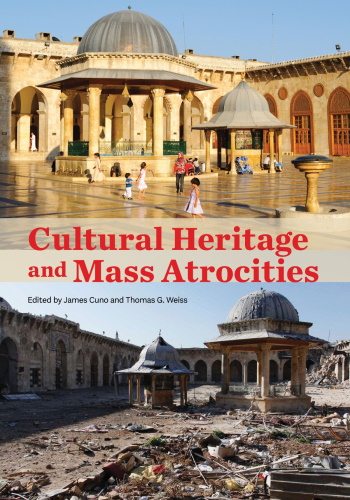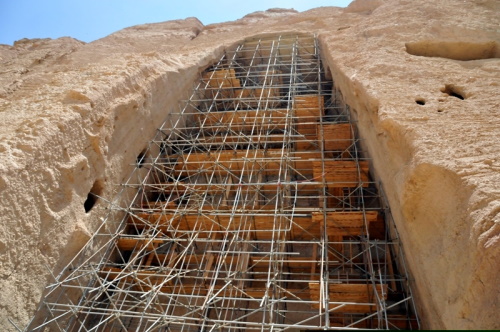Blog Books
Book: Cultural Heritage and Mass Atrocities
Just last week, a book has been published about the destruction of cultural heritage, with a large focus on the fate of WHS in this regard. “Cultural Heritage and Mass Atrocities” is a collection of 32 essays, compiled by James Cuno from the Getty Trust and international relations scholar Thomas G. Weiss. It addresses the deliberate destruction of cultural heritage in conflict, which has gained notoriety during the past decades in Mostar, Bamiyan and Palmyra. Its book cover shows “before” and “after” photos of the Great Mosque of Aleppo.

Memorable essays
The essays were all written recently (late 2021), which I found refreshing as they take into account developments such as the retaking of power by the Taliban in Afghanistan and the Ethiopian army’s actions in Tigray. The authors come from a broad spectrum, consisting of academics with backgrounds ranging from Guatemalan Maya to West Point Military Academy. Still, there is no Russian, Chinese, Saudi, Japanese, Turk, or Brazilian among them (to name a few players with a different view of the world than is common at UK/US universities).
The most notable among the essays I found:
- Chapters 3 and 4: Examples from the past, from the Roman destruction of Alexandria’s Serapeum to that of the Old Summer Palace by the British and the French during the Second Opium War.
- Chapter 7: Case study on the Uyghur heritage, which is not represented at all in China’s extensive list of WHS.
- Chapter 8: “Rebuilding” heritage in Afghanistan and Sri Lanka. Addresses the debate whether to reconstruct the Bamiyan Buddhas, although it omits the role of Japan.
- Chapter 10: Case study on Aleppo by former WHC director Francesco Bandarin, best for his views on “What next”.
- Chapter 12: Pros and cons regarding reconstruction in Syria.
- Chapter 14: Case study on Timbtuku, where international actions (including conviction of the perpetrators by the International Court of Justice) seem to eventually have worked.
- Chapter 27: How cultural lobbying (by the Vatican for example) influenced military decisions during World War II, such as the bombing of the Abbey of Monte Cassino.
- Chapter 30: Preservation of cultural heritage during peacekeeping missions, using the Serbian Monasteries in Kosovo as its main example.
Key messages
There's a feeling of helplessness surrounding this subject: prevention of these acts seems to be nearly impossible, and WHS have been placed 'in danger' mostly after the fact. This essay collection makes you think about a number of things:
- The deliberate destruction of objects that are known to be dear to the enemy is an old and widespread practice, not solely a product of non-state terrorist groups like ISIS or the Taliban.
- There are plenty of international laws that condemn this practice. The main issue is the enforcement.
- The preservation of immovable heritage (as incorporated in the WH list) is much more complex than that of artifacts or people, who can be brought to a safe place in due time. If you decide to physically protect a monument, that can be a long commitment.
- Who “owns” a heritage site, especially a WHS? Is it the local community, using it and making their livelihood out of it? Is it the State? Or the World? The answer to this could help in deciding who has to act as its protector.
- The State Party-centered approach to nominating WHS is particularly vulnerable to nationalist narratives and denial of diverse cultural beliefs. The suggestion is brought forward to require an accurate description of previous uses and users of locations nominated as a WHS.

Should you read it?
It’s a scientific book, with annotations and references. When you’re used to reading more scholarly works, most of the articles are quite easy to grasp. Only the first few articles (including the introduction by former UNESCO Director-General Irina Bokova) and Part 4 (which is about international law) are overly heavy on international treaties and the use of acronyms. The e-book is downloadable for free (“Reflecting Getty’s commitment to open content”), while the paperback version (648 pages) for some reason is sold at 85 USD.
Els - 25 September 2022
Comments
Jay T 26 September 2022
Though to be more accurate, the lawsuit is regarding the direct threat to the town of Huaraz from flooding due to melting glaciers, not specifically the endangerment of Huascaran. Still, it makes me wonder what other similar lawsuits may follow.
Jay T 26 September 2022
Sounds like a timely book, even if there are no easy answers for how to protect heritage sites in conflict zones. Th question of who is responsible for owning/protecting World Heritage Sites is an interesting one, too, since I was just reading an article this week about the ongoing lawsuit by a mountain guide in Huaraz, Peru, against the German energy company RWE (though admittedly this is endangerment of a WHS due to climate change, rather than conflict).